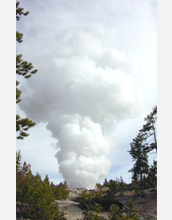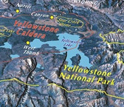|

Press Release 08-148
Yellowstone's Ancient Supervolcano: Only Lukewarm?

Molten plume of material beneath Yellowstone cooler than expected
August 27, 2008
The geysers of Yellowstone National Park owe their existence to the "Yellowstone hotspot"--a region of molten rock buried deep beneath Yellowstone, geologists have found. But how hot is this "hotspot," and what's causing it? In an effort to find out, Derek Schutt of Colorado State University and Ken Dueker of the University of Wyoming took the hotspot's temperature. The scientists published results of their research, funded by the National Science Foundation (NSF)'s division of earth sciences, in the August, 2008, issue of the journal Geology. "Yellowstone is located atop of one of the few large volcanic hotspots on Earth," said Schutt. "But though the hot material is a volcanic plume, it's cooler than others of its kind, such as one in Hawaii." When a supervolcano last erupted at this spot more than 600,000 years ago, its plume covered half of today's United States with volcanic ash. Details of the cause of the Yellowstone supervolcano's periodic eruptions through history are still unknown. Thanks to new seismometers in the Yellowstone area, however, scientists are obtaining new data on the hotspot. Past research found that in rocks far beneath southern Idaho and northwestern Wyoming, seismic energy from distant earthquakes slows down considerably. Using the recently deployed seismometers, Schutt and Dueker modeled the effects of temperature and other processes that affect the speed at which seismic energy travels. They then used these models to make an estimate of the Yellowstone hotspot's temperature. They found that the hotspot is "only" 50 to 200 degrees Celsius hotter than its surroundings. "Although Yellowstone sits above a plume of hot material coming up from deep with the Earth, it's a remarkably 'lukewarm' plume," said Schutt, comparing Yellowstone to other plumes. Although the Yellowstone volcano's continued existence is likely due to the upwelling of this hot plume, the plume may have become disconnected from its heat source in Earth's core. "Disconnected, however, does not mean extinct," said Schutt. "It would be a mistake to write off Yellowstone as a 'dead' volcano. A hot plume, even a slightly cooler one, is still hot."
-NSF-

Media Contacts
Cheryl Dybas, NSF (703) 292-7734 cdybas@nsf.gov

The National Science Foundation (NSF) is an independent federal agency that
supports fundamental research and education across all fields of science and
engineering, with an annual budget of $6.06 billion. NSF funds reach all 50
states through grants to over 1,900 universities and institutions. Each year,
NSF receives about 45,000 competitive requests for funding, and makes over
11,500 new funding awards. NSF also awards over $400 million in
professional and service contracts yearly.
 Get News Updates by Email Get News Updates by Email
Useful NSF Web Sites:
NSF Home Page: http://www.nsf.gov
NSF News: http://www.nsf.gov/news/
For the News Media: http://www.nsf.gov/news/newsroom.jsp
Science and Engineering Statistics: http://www.nsf.gov/statistics/
Awards Searches: http://www.nsf.gov/awardsearch/
| 



